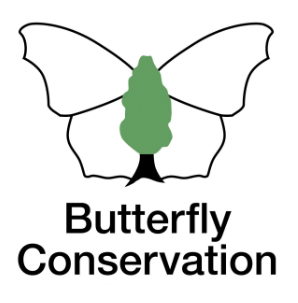Brown Argus
Brown Hairstreak
Chalkhill Blue
Clouded Yellow
Comma
Common Blue
Dark Green Fritillary
Dingy Skipper
Essex Skipper
Gatekeeper
Green Hairstreak
Green-veined White
Grizzled Skipper
Holly Blue
Large Skipper
Large White
Marbled White
Meadow Brown
Orange-tip
Painted Lady
Peacock
Purple Emperor
Purple Hairstreak
Red Admiral
Ringlet
Silver-washed Fritillary
Small Blue
Small Copper
Small Heath
Small Skipper
Small Tortoiseshell
Small White
Speckled Wood
Wall
White Admiral
White-letter Hairstreak
Extinct/rare immigrants
Comma
Polygonia c-album
General Distribution and Status
The Comma is now a common and widespread species in England and Wales. In recent years it has also been found in Scotland and is continuing its expansion. The butterfly was widely distributed in the early 19th century but began to decline by the middle of the century and became restricted to just a few areas around Herefordshire in 1913 after which a revival began. It is thought that the decline in the hop farming industry contributed to the demise of the Comma when hop was the butterfly's main larval foodplant at the time but the butterfly has adapted to use alternative foodplants, e.g. nettles, in the 20th century. It is possible that since females lay eggs on hazel in Europe (Tolman & Lewington) and I found a larva on this plant in 2017 (see below) hazel may be more widely used in future in the UK due to climate change. There seems to be some positive correlation between winter rainfall and abundance; rainfall for the winter in the year before (Palmer et al.), for example, winter 2007-8 for total counts in 2009 but this may not be a reliable hypothesis. The data used in the experiment used counts from transects and other monitored sites so counts for March may have been excluded. Since the 1970s numbers have increased by a significant amount nationally although a slight drop occurred in the last ten years which is also the case for Hertfordshire and Middlesex.
| United Kingdom | Herts & Middx | |||
| Distribution | 1976-2019 | +94% | 1980-2015 | +12% |
| Average 10-year trend | +14% | 2006-2015 | +13% | |
| 2024 since 2015-19 | +9% | |||
| Abundance | 1976-2024 | +171% | 1980-2015 | +25% |
| 2015-2024 | -8% | 2006-2015 | -13% | |
| 2023-2024 | -53% | 2024 since 2015-19 | -40% | |
UK distribution map
UKBMS Species summary
Habitat Requirements
This species is more likely to be seen in open wooded areas and hedgerows in the spring but are more regularly found in gardens to feed on nectar and rotting fruit in late summer and the autumn.
Larval Foodplants
Common Nettle Urtica dioica, Wych Elm Ulmus glabra, English Elm Ulmus procera. Sawford mentions Hop Humulus lupulus and Currants Ribes spp. Larvae fed on Hazel Corylus avellana in captivity (Allan) and I found one on this plant in the wild in Stevenage in 2017 (Clarke).
Adult Food Sources
Buddleia Buddleja davidii (528), Common Michaelmas Daisy Aster x salignus (115), Butterfly Stonecrop Sedum spectable (108), Confused Michaelmas Daisy Aster novi-belgii (85), Bramble Rubus fruticosus (82).
Historical Records
There were no reports from the Stevenage area until 1935 although it was probably present in the early 19th century when it was known to be widely distributed as noted above. Ray Palmer saw several specimens on 28 July 1935 near Pigeonswick Cottage and Roger Ferry found it on two occasions in Knebworth Great Wood in 1946. It also appeared in the Walkern area in 1942 (Birdsall). The butterfly continued its expansion up until the 1980s when Waterton in his 1970-81 survey refers to it as 'one of the few species which can be said to have increased in numbers over the last 20 years or so'.
Local Distribution and Abundance
As shown on the map, the Comma is widely distributed in the Stevenage area. It is never seen in great numbers with only a few visits yielding more than a dozen specimens but numbers have increased in the last few years. 2017 was the best year in terms of abundance with 336 inviduals counted and the most reports occurred in 2020 with 181. Knebworth Park and Fairlands Valley Park appear to be the best places to find the butterfly. On 10 July 2023, a record count of 22 individuals were seen in the Knebworth Woods area during a Wider Countryside Butterfly Survey. 2023 and 2024 had poor starts in terms of numbers and although numbers rose in the late summer of 2023 they did not in 2024.

Stevenage (South Fairlands Valley Park) transect 1993-2025
Since 2002 numbers of the Comma have been reasonably consistent and the long-term trend is slightly up in spite of a small fall in abundance in the last 5 years. The years of the highest abundance, 2006 and 2009, were dominated by strong showings in overwintering individuals in the spring. In 2006, more than half the annual total was recorded in the first two weeks of April alone and in 2009, more than half in March.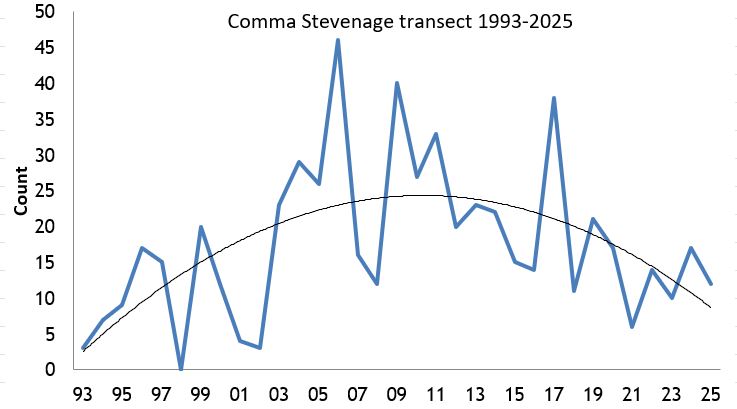
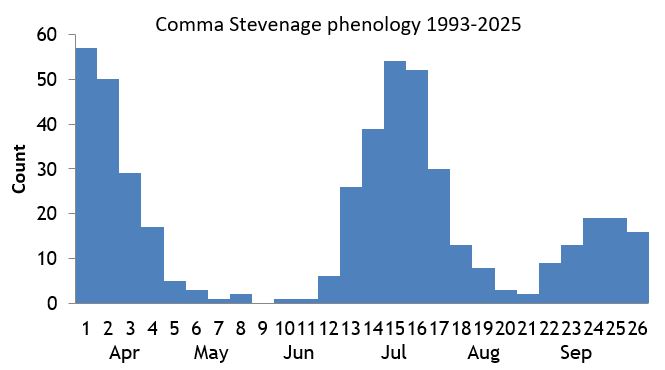
Knebworth Park transect 1996-2010 and 2017-2025
Numbers were highest during the 2000-2009 decade but since there are no records between 2011 and 2016 we cannot be sure if the small downward trend would have continued into the last decade. However, the 2017 total of 24 is nearly double the average for the 1996-2010 period. Curiously there are proportionately far fewer sightings here in April than in Stevenage but higher in September. There were no sightings at all in 2018 which in all probability was indirectly due to the cold weather in the spring as explained above.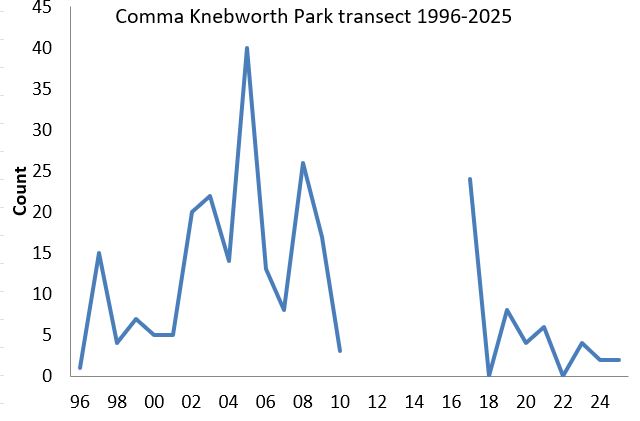
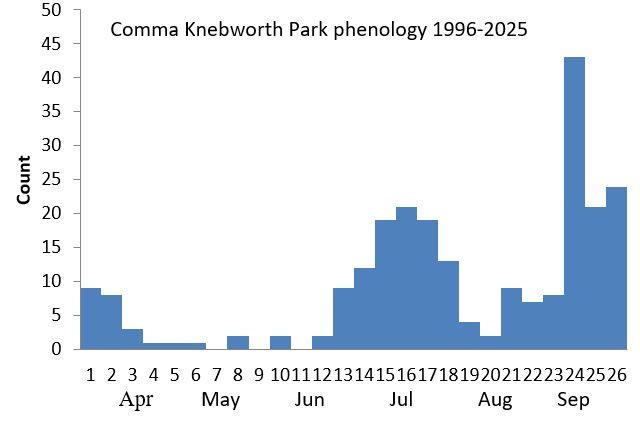
Knebworth Woods transect 2017-2025
45 specimens were counted in 2017 but only four in 2018, the majority of which were found at Norton Green Common of which only one was observed in late summer. The other two local transects also saw much lower numbers than usual in late summer/autumn in 2018. However, good numbers occurred in the following years including 10 on 3 July 2022.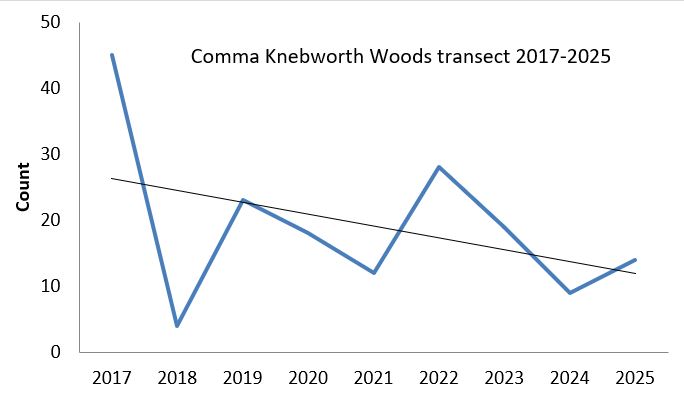
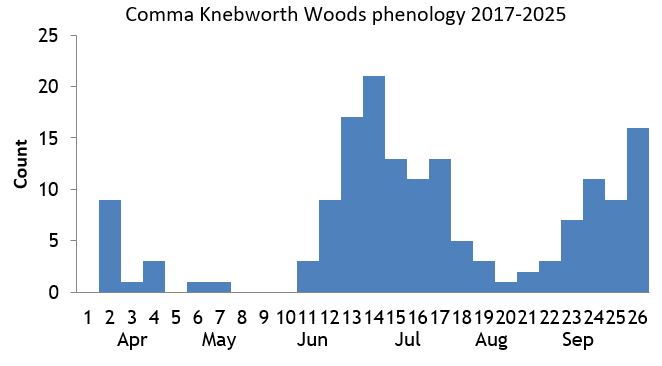
Pryor's Wood transect 2000-2022
Usually two or three individuals are reported each year although in the 2005-09 period the butterfly was more abundant with nine counted in 2009, for example. Three specimens were reported in 2020, none in 2021 and one in 2022.Life History
Earliest date: 21 February 2009 at Monks Wood
Latest date: 1 November 1996 at Aston
The Comma produces two generations a year. Emergence from
hibernation usually starts in March and the butterfly is on the wing until the end of April. The quicker developing larvae resulting from the first generation
will produce a second generation in late June and July of the hutchinsoni form which have paler wings than the normal form. The slower developing
larvae will however, produce the normal form in late July and early August. The female hutchinsoni form will also lay eggs and produce a new brood
of the normal form in late August and September. By November, adults will go into hibernation. Eggs are laid singly towards the edge of a leaf of the
foodplant. Larvae feed on the leaves and look like bird droppings when mature. The pupa is suspended attached to the foodplant or surrounding vegetation.
Behaviour/Observation notes
Males establish territories on woodland rides and hedgerows, and often perch for long periods on a favourite twig or leaf. In the spring, the butterfly sometimes feeds on willow flowers. In the summer and autumn, individuals due to enter hibernation are more sedentary but will occasionally visit gardens to feed on flowers and fruit like blackberries. Animal faeces and carcasses may attract the Comma too.
Variations/Aberrations
There are several variations and aberrations for the Comma. One of the apparently more common aberrations, ab. reichstettensis was seen by Robert
Callf on 18 June 2009 in the Enfield area. This aberration is formed where some of the black spots on the forewings are merged and the hindwings are even
more heavily dusted with black.
Find out more on the UK Butterflies website
References
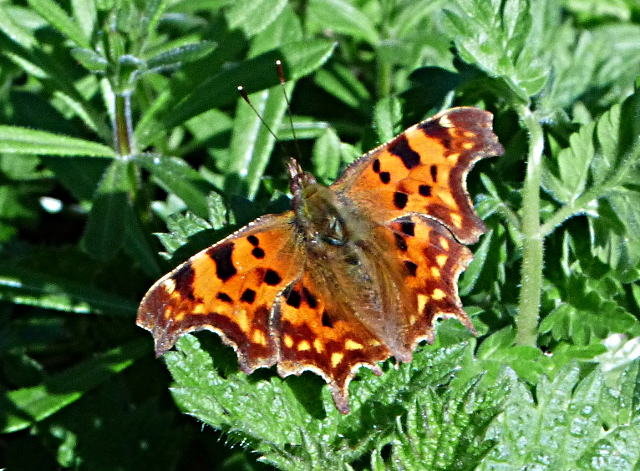
Fairlands Valley Park 15 Mar 2017

Norton Green Common 2 Jul 2019 (hutchinsoni)
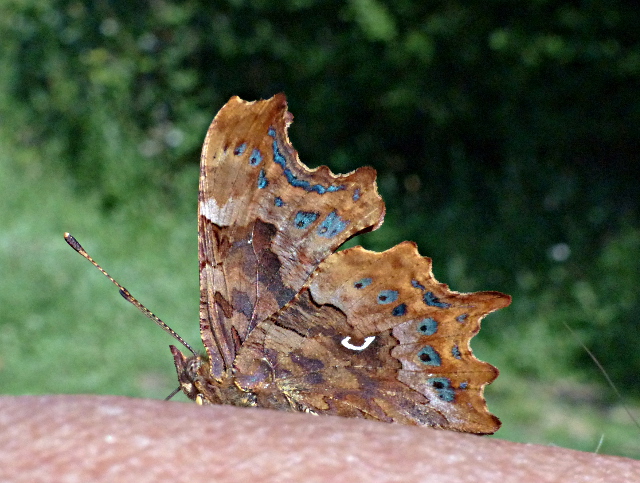
Norton Green Common 19 Jun 2017
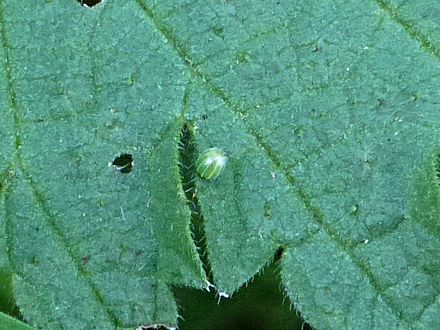
Egg Millennium Wood 5 Apr 2017

Larva on hazel Millennium Wood 1 Aug 2017

Pupa on hop garden 2 Sep 2019
